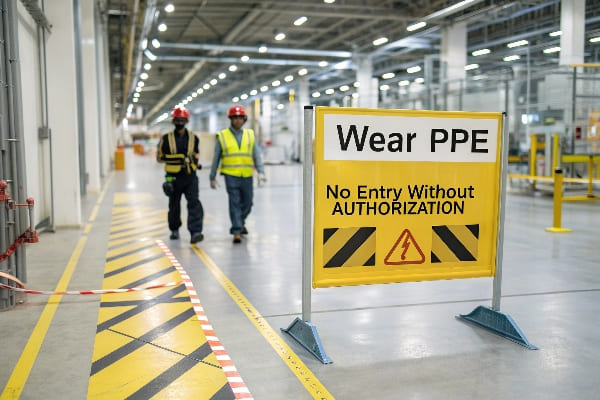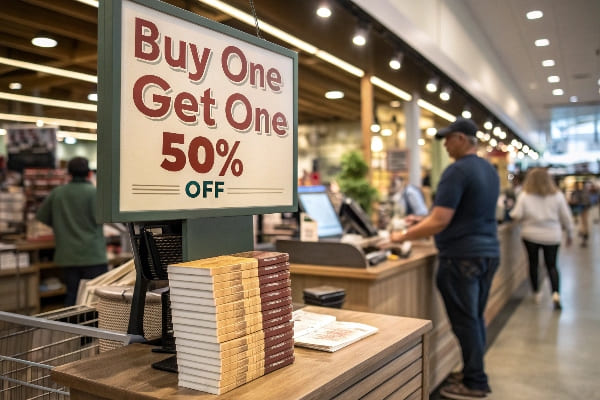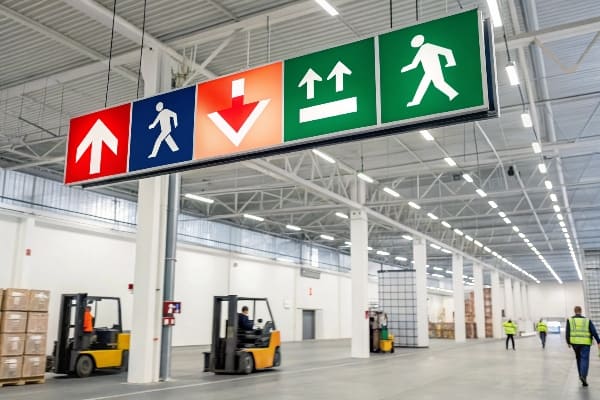Visitors wander, staff repeat directions, products stay hidden, and deadlines loom. I felt that pain until I covered my walls with clear, bright messages.
Indoor signage improves navigation, builds brand memory, supports safety rules, and boosts on-site sales. Clear signs turn empty walls into silent staff, guiding users, reinforcing trust, and moving products faster inside any facility.

I will walk you through the four key areas where good signage makes a direct difference, just as it did in my own factory and showrooms.
Why is signage important in the workplace?
Accidents rise, new hires freeze, and visitors question your standards. I once lost a full day fixing confusion on the shop floor. The right signs solved that.
Workplace signage sets clear rules, reduces accidents, and frees staff to focus on real work instead of giving directions.

Safety keeps teams moving
I learned early that cardboard dust near cutters is a fire risk. Bright red “No Smoking1” panels and yellow hazard arrows dropped near-miss events to zero in one quarter. Safety signs remind workers of eyewear, forklifts, and chemical zones. Regulations demand proof, and a dated sign log satisfies audits without extra paperwork.
Efficiency lifts morale
Directional arrows2 to raw-material racks cut search time. Hourly output rose when operators stopped walking blind loops. A simple “Line 1 / Line 2” banner added 3% productivity, according to my own stopwatch checks.
Communication builds culture
Posters with our slogan, Outstanding Design Made Easy!3, welcome visitors and inspire pride. New hires see values before they meet managers. Clear language and icons erase language barriers for overseas crews.
| Sign Type | Immediate Gain | Long-Term Gain |
|---|---|---|
| Danger / PPE | Fewer injuries | Lower insurance costs |
| Directional | Faster task start | Less overtime |
| Motivational | Higher morale | Lower turnover |
Every square meter of wall space can speak. Use simple words, bold colors, and icons. Inspect signs monthly and replace faded pieces. The message must stay strong.
Why is signage important in a store?
Customers pause, doubt prices, and leave empty-handed. I watched a retailer lose weekend sales until we refreshed his point-of-purchase signs.
Retail signage guides traffic flow, highlights value, and turns browsers into buyers at the last moment.

Navigation drives dwell time4
Wide aisles feel safer when “Hunting Gear →” signs stand above eye level. Visitors reach the crossbow display faster and stay longer. Heat-map data from partners showed a 15% rise in time spent near end-caps after adding simple aisle markers.
Promotion sparks impulse5
A bright cardboard header shouting “New 400 FPS Crossbow” with a price drop creates urgency. My team designs die-cut arrows that point straight to the trigger display. When we tested a red price burst, unit sales doubled that weekend.
Branding anchors memory
Consistent fonts, colors, and logos build recall. Customers snap photos of displays for social media. That free exposure matters more than paid ads. When Barnett Outdoors used our matching shelf talkers, hashtag posts rose by a third in one month.
| Goal | Sign Design Tip | Result |
|---|---|---|
| Drive traffic | Overhead aisle blades | Higher footfall |
| Raise basket size | Bundle price wobblers | Add-on sales |
| Build loyalty | QR codes to tutorials | Repeat visits |
Clear, honest signs respect shoppers. They act as silent staff, smiling without wages.
Why is signage important in visual merchandising?
Products look dull, colors clash, and themes confuse. I once set up a demo without signs; it felt like a yard sale. Signs pull the story together.
Visual-merchandising signage links product, theme, and emotion, turning displays into immersive experiences that boost perceived value.

Storytelling sells experiences
A cardboard backdrop of a forest pairs with camo bows. Wooden-style nameplates add texture. Customers imagine hunting trips, not just gear specs. The sign’s tone—bold fonts, earth colors—sets a mood that packaging alone cannot.
Layering guides the eye
Use hierarchy: headline, feature, benefit. A top banner reads “Silent Recurve Series6,” a mid card says “Light 2.5 kg,” and a small tag notes “Free wax kit7.” Eyes move top to bottom, locking on each value point. Tests show a 22% lift in add-on wax kits when the small tag is present.
Consistency strengthens brand
My design crew keeps RGB codes and Pantone references8 on file. Every in-store sign mirrors our online banners. Customers jump from phone to shelf without visual friction, raising trust.
| Layer | Sign Example | Purpose |
|---|---|---|
| Header | Large foam board | Sets theme |
| Mid | Die-cut feature card | Shows key benefit |
| Detail | Shelf-edge strip | Gives price, QR |
Rotate themes monthly. Fresh signs make old stock feel new.
What is indoor signage?
Many people think only of banners. Indoor signage is much wider. I learned to treat every surface as media.
Indoor signage covers any message inside a building—walls, floors, ceilings, shelves, and digital screens—all used to inform, direct, or persuade people.

Categories you can deploy
- Directional: Arrows, maps, floor graphics.
- Informational: Hours, services, Wi-Fi codes.
- Regulatory: Safety rules, exits, capacity.
- Promotional: Sales, bundles, new arrivals.
- Branding: Logos, slogans, mission statements.
Materials matter
Cardboard9 remains my core. It is light, green, and cheap for short runs. For high traffic, acrylic or aluminum lasts longer. Digital screens allow motion but cost more.
Placement strategy10
I follow a simple rule: eye-level for reading, overhead for moving, floor for warning. Measure sightlines from entrances. Place the most essential sign where a first-time guest stops and looks up.
| Sign Group | Best Material | Life Span |
|---|---|---|
| Short-term promo | Corrugated cardboard | 2–3 months |
| Long-term safety | Aluminum | 5+ years |
| Interactive info | Touch screen | Software-dependent |
Start with a sign audit. Walk your space like a new visitor. Note every moment of hesitation. Add a sign there. Repeat each quarter. Improvement never ends.
Conclusion
Indoor signs speak for you when you cannot. Use them to guide, protect, persuade, and grow.
Explore this link to understand how effective fire safety signage can prevent workplace accidents and ensure compliance. ↩
Learn how directional signs can streamline operations and enhance productivity in your facility. ↩
Discover how impactful slogans can boost employee morale and foster a positive work culture. ↩
Understanding dwell time can help improve store layouts and increase customer engagement, making it essential for retailers to explore this topic. ↩
Exploring how promotions drive impulse buying can provide valuable insights for enhancing sales strategies and customer experiences. ↩
Discover the features and benefits of the Silent Recurve Series to enhance your archery experience. ↩
Learn how a free wax kit can improve your archery gear maintenance and performance. ↩
Explore the importance of RGB codes and Pantone references for maintaining brand consistency in design. ↩
Explore the advantages of cardboard in signage, including its eco-friendliness and cost-effectiveness for short-term use. ↩
Learn effective placement strategies to enhance visibility and communication through signage in various environments. ↩

